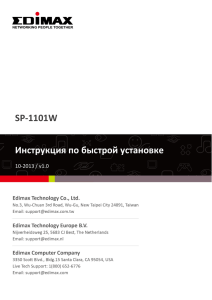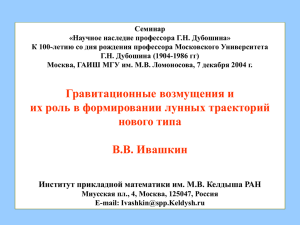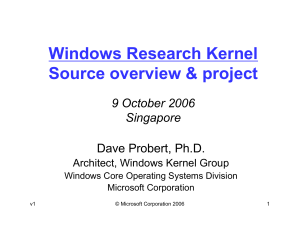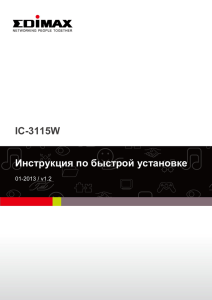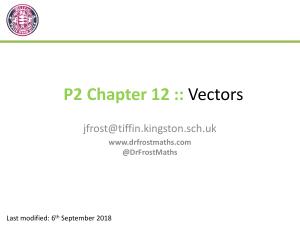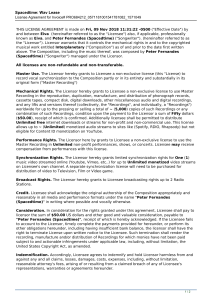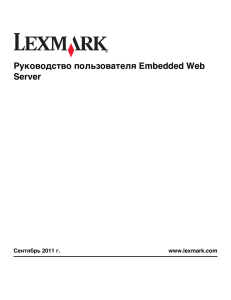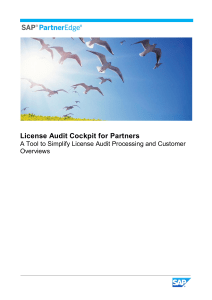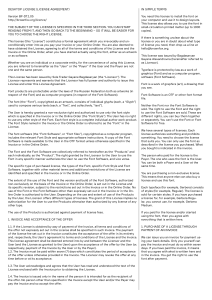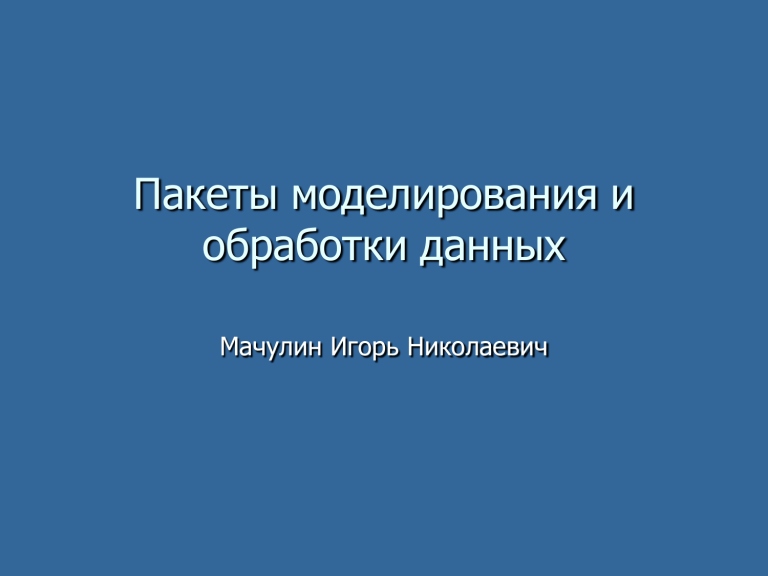
Пакеты моделирования и обработки данных Мачулин Игорь Николаевич Программное обеспечение для физики элементарных частиц и ядра. •Разработчик – ЦЕРН •ОС – Линукс •Язык программирования – С++ •Пакеты на основе С++ : 1) Root – обработка больших массивов информации с детекторов, проведение статистического анализа, проверка гипотез, представление результатов 2) Geant4 – моделирование методом Монте-Карло физических процессов в детекторах частиц 2 Root – data analyses framework ROOT Browser ALICE Various Projections Simulated Pb-Pb event in ALICE detector 3 Geant4 – simulation toolkit for particles High Energy Physics Experiments 4 Операционная система • Операционная система , сокр. ОС (англ. operating system, OS) — комплекс управляющих и обрабатывающих программ, которые, с одной стороны, выступают как интерфейс между устройствами вычислительной системы и прикладными программами, а с другой стороны — предназначены для управления устройствами, управления вычислительными процессами, эффективного распределения вычислительных ресурсов между вычислительными процессами и организации надѐжных вычислений. Это определение применимо к большинству современных ОС общего назначения. 5 •В логической структуре типичной вычислительной системы ОС занимает положение между устройствами с их микроархитектурой, машинным языком и, возможно, собственными (встроенными) микропрограммами — с одной стороны — и прикладными программами с другой. •Разработчикам программного обеспечения ОС позволяет абстрагироваться от деталей реализации и функционирования устройств, предоставляя минимально необходимый набор функций. •В большинстве вычислительных систем ОС является основной, наиболее важной (а иногда и единственной) частью системного ПО. С 1990-х наиболее распространѐнными операционными системами являются ОС семейства Microsoft Windows и системы класса UNIX (особенно Linux и Mac OS). 6 Linux Linux— общее название Unix-подобных операционных систем на основе одноимѐнного ядра, библиотек и системных программ, разработанных в рамках проекта GNU, а так же другого программного обеспечения. •GNU's Not UNIX — «GNU — не UNIX» — свободная Unix-подобная операционная система, разрабатываемая Проектом GNU. •Linux работает на множестве архитектур процессора, таких как Intel x86, x86-64, PowerPC, ARM, Alpha AXP, Sun SPARC, Motorola 68000, Hitachi SuperH, IBM S/390, MIPS, HP PA-RISC, AXIS CRIS, Renesas M32R, Atmel AVR32, Renesas H8/300, NEC V850, Tensilica Xtensa и многих других. 7 В отличие от большинства других операционных систем, Linux не имеет единой «официальной» комплектации. Вместо этого Linux поставляется в большом количестве так называемых дистрибутивов, в которых ядро Linux соединяется с утилитами GNU и другими прикладными программами (например, X.org), делающими еѐ полноценной многофункциональной операционной средой. •Наиболее известными и используемыми дистрибутивами Linux в физике элементарных частиц (ЦЕРН) являются: Debian, Fedora, ScientificLinux, Ubuntu. 8 Язык программирования С++ •C++ — компилируемый статически типизированный язык программирования общего назначения. Поддерживая разные парадигмы программирования, сочетает свойства как высокоуровневых, так и низкоуровневых языков. В сравнении с его предшественником — языком C, — наибольшее внимание уделено поддержке объектно-ориентированного и обобщѐнного программирования. Название «C++» происходит от названия языка C, в котором унарный оператор ++ обозначает инкремент переменной. 9 Являясь одним из самых популярных языков программирования, C++ широко используется для разработки программного обеспечения. Область его применения включает создание операционных систем, разнообразных прикладных программ, драйверов устройств, приложений для встраиваемых систем, высокопроизводительных серверов, а также развлекательных приложений (например, видеоигры). Существует несколько реализаций языка C++ — как бесплатных, так и коммерческих. Их производят Проект GNU, Microsoft, Intel и Embarcadero (Borland). 10 Основная литература http://www.cern.ch http://geant4.web.cern.ch/geant4/ http://root.cern.ch/ С.М. Ермаков. Метод Монте-Карло и смежные вопросы. Наука. 1975. И.М. Соболь. Метод Монте-Карло. Наука. 1985. Х. Гульд, Я. Тобочник. Компьютерное моделирование в физике. Мир. 1990. Р. Лафоре, Объектно-ориентированное программирование в С++, из-во Питер, СПб, 2011. Г. Шилдт, Самоучитель С++ 11 Geant4 General introduction and brief history Contents General introduction and brief history Highlights of user applications Geant4 kernel Basic concepts and kernel structure User classes Primary particle generation 13 What is Geant4? Geant4 is the successor of GEANT3, the world-standard toolkit for HEP detector simulation. Geant4 is one of the first successful attempt to re-design a major package of HEP software for the next generation of experiments using an Object-Oriented environment. A variety of requirements also came from heavy ion physics, CP violation physics, cosmic ray physics, astrophysics, space science and medical applications. In order to meet such requirements, a large degree of functionality and flexibility are provided. G4 is not only for HEP but goes well beyond that. 14 Flexibility of Geant4 In order to meet wide variety of requirements from various application fields, a large degree of functionality and flexibility are provided. Geant4 has many types of geometrical descriptions to describe most complicated and realistic geometries Everything is open to the user Choice of physics processes/models Choice of GUI/Visualization/persistency/histogramming technologies 15 Physics in Geant4 It is rather unrealistic to develop a uniform physics model to cover wide variety of particles and/or wide energy range. Much wider coverage of physics comes from mixture of theory-driven, parameterized, and empirical formulae. Thanks to polymorphism mechanism, both cross-sections and models (final state generation) can be combined in arbitrary manners into one particular process. Geant4 offers EM processes Hadronic processes Photon/lepton-hadron processes Optical photon processes Decay processes Shower parameterization Event biasing techniques And you can plug-in more 16 Physics in Geant4 Each cross-section table or physics model (final state generation) has its own applicable energy range. Combining more than one tables / models, one physics process can have enough coverage of energy range for wide variety of simulation applications. Geant4 provides sets of alternative physics models so that the user can freely choose appropriate models according to the type of his/her application. Several individual universities / physicists groups are contributing their physics models to Geant4. Given the modular structure of Geant4, developers of each physics model are well recognized. 17 Introduction to Geant4 - M.Asai (SLAC) 18 HARP Geant4 Collaboration Univ. Barcelona Lebedev Helsinki Inst. Ph. PPARC Collaborators also from nonmember institutions, including Budker Inst. of Physics IHEP Protvino MEPHI Moscow Pittsburg University 19 Highlights of Users Applications http://www.in-cites.com/hotpapers/2004/november04-eng.html http://www.in-cites.com/hotpapers/2005/jan05-eng.html http://www.in-cites.com/hotpapers/2005/mar05-eng.html http://www.in-cites.com/hotpapers/2005/may05-eng.html http://www.in-cites.com/hotpapers/2005/july05-eng.html Kernel I - M.Asai (SLAC) 21 http://top25.sciencedirect.com/jo urnal/01689002/ Kernel I - M.Asai (SLAC) 22 Kernel I - M.Asai (SLAC) 23 Highlights of Users Applications To provide you some ideas how Geant4 would be utilized… BaBar BaBar at SLAC is the pioneer experiment in HEP in use of Geant4 Started in 2000 Simulated ~2*1010 events so far Produced at 20 sites in North America and Europe Now simulating PEP beam line as well (-9m < zIP < 9m) CourtesyKernel of D.Wright I - M.Asai (SLAC) (SLAC) 25 Large Hadron Collider (LHC) @ CERN 26 Kernel I - M.Asai (SLAC) 27 Geant4 has been successfully employed for Detector design Calibration / alignment First analyses T. LeCompte (ANL) Figures from CMS 28 Missing ET 29 Data and simulation agreements 30 Boulby Mine dark matter search Prototype Simulation Courtesy of H. Araujo, A. Howard, IC London One High Energy event mirror LXe GXe PMT source Kernel I - M.Asai (SLAC) 31 Geant4 for beam transportation Kernel I - M.Asai (SLAC) 32 Courtesy of G.Blair (CERN) 33 X-ray Multi-Mirror mission (XMM) X-ray detectors (CCDs) Telescope tube Mirrors Launch December 1999 Perigee 7000 km apogee 114000 km Flight through the radiation belts Baffles Kernel I - M.Asai (SLAC) 34 g astrophysics AGILE GLAST g-ray bursts GLAST GLAST Typical telescope: Tracker Calorimeter Anticoincidence g conversion electron interactions multiple scattering d-ray production charged particle tracking Kernel I - M.Asai (SLAC) 35 Kernel I - M.Asai (SLAC) 36 Courtesy T. Ersmark, KTH Stockholm Geant4 in space science Cosmic rays, jovian electrons ESA Space Environment & Effects Analysis Section X-Ray Surveys of Asteroids and Moons Solar X-rays, e, p Geant3.21 G4 ―standard‖ Courtesy SOHO EIT Induced X-ray line emission: indicator of target composition (~100 mm surface layer) Geant4 low-E C, N, O line emissions included 37 Bepi Colombo: X-Ray Mineralogical Survey of Mercury BepiColombo ESA cornerstone mission to Mercury Courtesy of ESA Astrophysics Space Environments and Effects Section Alfonso Mantero, Thesis, Univ. Genova, 2002 Kernel I - M.Asai (SLAC) 38 PlanetoCosmics Geant4 simulation of Cosmic Rays in planetary Atmo-/Magneto- spheres Kernel I - M.Asai (SLAC) 39 PlanetoCosmics Mars field and atmosphere NASA Mars-GRAM2001 model p,n, T in function of : Lat., long. (topography from MOLA) Altitude, season, local time, F10.7 Dust models Based on : NASA MGCM 0-80 km Univ. of Arizona MTGCM 80-170 km MGS observation Br @ 400 km Connerney et al., Geophys.Res.Let. 28, 21, 4015-4018, 2001 Cain 50-degree spherical harmonic model (2003) Geant4 implementation courtesy L. Desorgher, University of Bern 40 Solar event gamma-rays • • Electron Bremsstrahlung – induced gammas in solar flares Compton back-scattering ! observable gamma-ray spectrum much softer than predicted by simple analytic calculations Application of Radiation Transport Simulator Geant4 to Space and Medical Science M. Asai (SLAC) Kernel I - M.Asai (SLAC) 1 41 Kernel I - M.Asai (SLAC) 42 ASTRO-H (1) SXI and SXS 43 ASTRO-H (2) Point source on HXI Left; center; right - 0arcmin; 2arcmin; 4arcmin top; bottom - 10keV; 30keV Kepler SNR on HXI (very preliminary) 44 ASTRO-H (3) Kernel I - M.Asai (SLAC) 45 Kernel I - M.Asai (SLAC) 46 GEANT4 based proton dose calculation in a clinical environment: technical aspects, strategies and challenges Harald Paganetti Kernel I - M.Asai (SLAC) 47 Screen shots of gMocren 48 49 Geant4 license The New Geant4 License In response to user requests for clarification of Geant4’s distribution policy, the collaboration recently announced a new license. •Makes clear the user’s wideranging freedom to use, extend or redistribute Geant4, even as part of some forprofit venture. •The license was released along with the latest Geant4 release 8.1. •Simple enough that you can read and understand it. •http://cern.ch/geant4/license/ 51 The Geant4 License License has 8 points. The points are written clearly and simply. 1,2 and 3) Tell the world who the software came from, and don’t claim you are us. Installation, use, reproduction, display, modification and redistribution of this software, with or without modification, in source and binary forms, are permitted on a non- exclusive basis. Any exercise of rights by you under this license is subject to the following conditions: 1. Redistributions of this software, in whole or in part, with or without modification, must reproduce the above copyright notice and these license conditions in this software, the user documentation and any other materials provided with the redistributed software. 2. The user documentation, if any, included with a redistribution, must include the following notice: "This product includes software developed by Members of the Geant4 Collaboration ( http://cern.ch/geant4 )." If that is where third-party acknowledgments normally appear, this acknowledgment must be reproduced in the modified version of this software itself. 3. The names "Geant4” and “The Geant4 toolkit” may not be used to endorse or promote software, or products derived therefrom, except with prior written permission by [email protected]. If this software is redistributed in modified form, the name and reference of the modified version must be clearly distinguishable from that of this software. 52 The Geant4 License 4) If you choose to give it away free to everyone, we can have it for free too. 5) You can’t patent the parts we did. 4. You are under no obligation to provide anyone with any modifications of this software that you may develop, including but not limited to bug fixes, patches, upgrades or other enhancements or derivatives of the features, functionality or performance of this software. However, if you publish or distribute your modifications without contemporaneously requiring users to enter into a separate written license agreement, then you are deemed to have granted all Members and all Copyright Holders of the Geant4 Collaboration a license to your modifications, including modifications protected by any patent owned by you, under the conditions of this license. 5. You may not include this software in whole or in part in any patent or patent application in respect of any modification of this software developed by you. 53 The Geant4 License We don’t claim that it works, and we’re not responsible if it doesn’t. 6. DISCLAIMER THIS SOFTWARE IS PROVIDED BY THE MEMBERS AND COPYRIGHT HOLDERS OF THE GEANT4 COLLABORATION AND CONTRIBUTORS "AS IS" AND ANY EXPRESS OR IMPLIED WARRANTIES, INCLUDING, BUT NOT LIMITED TO, IMPLIED WARRANTIES OF MERCHANTABILITY, OF SATISFACTORY QUALITY, AND FITNESS FOR A PARTICULAR PURPOSE OR USE ARE DISCLAIMED. THE MEMBERS OF THE GEANT4 COLLABORATION AND CONTRIBUTORS MAKE NO REPRESENTATION THAT THE SOFTWARE AND MODIFICATIONS THEREOF, WILL NOT INFRINGE ANY PATENT, COPYRIGHT, TRADE SECRET OR OTHER PROPRIETARY RIGHT. 7. LIMITATION OF LIABILITY THE MEMBERS AND COPYRIGHT HOLDERS OF THE GEANT4 COLLABORATION AND CONTRIBUTORS SHALL HAVE NO LIABILITY FOR DIRECT, INDIRECT, SPECIAL, INCIDENTAL, CONSEQUENTIAL, EXEMPLARY, OR PUNITIVE DAMAGES OF ANY CHARACTER INCLUDING, WITHOUT LIMITATION, PROCUREMENT OF SUBSTITUTE GOODS OR SERVICES, LOSS OF USE, DATA OR PROFITS, OR BUSINESS INTERRUPTION, HOWEVER CAUSED AND ON ANY THEORY OF CONTRACT, WARRANTY, TORT (INCLUDING NEGLIGENCE), PRODUCT LIABILITY OR OTHERWISE, ARISING IN ANY WAY OUT OF THE USE OF THIS SOFTWARE, EVEN IF ADVISED OF THE POSSIBILITY OF SUCH DAMAGES. 8. This license shall terminate with immediate effect and without notice if you fail to comply with any of the terms of this license, or if you institute litigation against any Member or Copyright Holder of the Geant4 Collaboration with regard to this software. 54 Basic concepts and kernel structure Geant4 kernel Geant4 consists of 17 categories. Geant4 Independently developed and maintained by WG(s) responsible to each Visuali zation category. global architecture WG. Geant4 Kernel Persis tency Event Tracking Digits + Hits Processes Track Handles run, event, track, step, hit, trajectory. Run Interfaces between categories (e.g. top level design) are maintained by the Inter faces Readout Geometry Particle Graphic _reps Material Provides frameworks of geometrical representation and physics processes. Intercoms Global 56 Geant4 as a state machine Geant4 has six application states. G4State_PreInit G4State_Idle initialize Idle beamOn exit GeomClosed Quit An event is processing G4State_Quit Geometry is optimized and ready to process an event G4State_EventProc PreInit Ready to start a run G4State_GeomClosed Material, Geometry, Particle and/or Physics Process need to be initialized/defined EventProc (Normal) termination G4State_Abort A fatal exception occurred and program is aborting Abort 57 Run in Geant4 As an analogy of the real experiment, a run of Geant4 starts with ―Beam On‖. Within a run, the user cannot change detector geometry settings of physics processes ---> detector is inaccessible during a run Conceptually, a run is a collection of events which share the same detector conditions. At the beginning of a run, geometry is optimized for navigation and cross- section tables are calculated according to materials appear in the geometry and the cut-off values defined. G4RunManager class manages processing a run, a run is represented by G4Run class or a user-defined class derived from G4Run. G4UserRunAction is the optional user hook. 58 Event in Geant4 At beginning of processing, an event contains primary particles. These primaries are pushed into a stack. When the stack becomes empty, processing of an event is over. G4EventManager class manages processing an event. G4Event class represents an event. It has following objects at the end of its processing. List of primary vertexes and particles (as input) Hits collections Trajectory collection (optional) Digits collections (optional) G4UserEventAction is the optional user hook. 59 Track in Geant4 Track is a snapshot of a particle. Step is a ―delta‖ information to a track. it goes out of the world volume it disappears (e.g. decay) it goes down to zero kinetic energy and no ―AtRest‖ additional process is required the user decides to kill it No track object persists at the end of event. Track is not a collection of steps. Track is deleted when It has only position and physical quantities of current instance. For the record of track, use trajectory class objects. G4TrackingManager manages processing a track, a track is represented by G4Track class. G4UserTrackingAction is the optional user hook. 60 Step in Geant4 Step has two points and also ―delta‖ information of a particle (energy loss on the step, time-of-flight spent by the step, etc.). Each point knows the volume (and material). In case a step is limited by a volume boundary, the end point physically stands on the boundary, and it logically belongs to the next volume. Because one step knows materials of two volumes, boundary processes such as transition radiation or refraction could be simulated. G4SteppingManager class manages processing a step, a step is represented by G4Step class. G4UserSteppingAction is the optional user hook. Boundary Step End of step point Begin of step point 61 Particle in Geant4 A particle in Geant4 is represented in three layers of classes. G4Track Position, geometrical information, etc. This is a class representing a particle to be tracked. G4DynamicParticle "Dynamic" physical properties of a particle, such as momentum, energy, spin, etc. Each G4Track object has its own and unique G4DynamicParticle object. This is a class representing an individual particle (which is not necessarily to be tracked). G4ParticleDefinition "Static" properties of a particle, such as charge, mass, life time, decay channels, etc. G4ProcessManager which describes processes involving to the particle All G4DynamicParticle objects of same kind of particle share the same G4ParticleDefinition. 62 Tracking and processes Geant4 tracking is general. It is independent to the particle type the physics processes involving to a particle It gives the chance to all processes To contribute to determining the step length To contribute any possible changes in physical quantities of the track To generate secondary particles To suggest changes in the state of the track e.g. to suspend, postpone or kill it. 63 Processes in Geant4 In Geant4, particle transportation is a process as well, by which a particle interacts with geometrical volume boundaries and field of any kind. Because of this, shower parameterization process can take over from the ordinary transportation without modifying the transportation process. Each particle has its own list of applicable processes. At each step, all processes listed are invoked to get proposed physical interaction lengths. The process which requires the shortest interaction length (in space-time) limits the step. Each process has one or combination of the following natures. AtRest AlongStep (a.k.a. continuous process) e.g. muon decay at rest e.g. Cerenkov process PostStep (a.k.a. discrete process) e.g. decay on the fly 64 Cuts in Geant4 A Cut in Geant4 is a production threshold. Only for physics processes that have infrared divergence Not tracking cut, which does not exist in Geant4 as default Energy threshold must be determined at which discrete energy loss is replaced by continuous loss Old way: Create secondaries only above cut-off energy, or add to continuous loss of primary for less energetic secondaries Track primary particle until cut-off energy is reached, calculate continuous loss and dump it at that point, stop tracking primary Geant4 way: Create secondaries only above specified range, or add to continuous loss of primary for secondaries of less energetic than travelling the required range in the current material Track primary down to zero range 65 Unit system Internal unit system used in Geant4 is completely hidden not only from user’s code but also from Geant4 source code implementation. Each hard-coded number must be multiplied by its proper unit. radius = 10.0 * cm; kineticE = 1.0 * GeV; To get a number, it must be divided by a proper unit. G4cout << eDep / MeV << “ [MeV]” << G4endl; Most of commonly used units are provided and user can add his/her own units. By this unit system, source code becomes more readable and importing / exporting physical quantities becomes straightforward. For particular application, user can change the internal unit to suitable alternative unit without affecting to the result. 67 User classes The user has to… Define material and geometry Select appropriate particles and processes Define production threshold(s) Define the way of primary particle generation Define the way to extract useful information from Geant4 Optionally, Define the way of visualization and interactivity Provide the way of I/O Select or provide some artificial mechanism for effective simulation etc. 69 User classes Initialization classes Use G4RunManager::SetUserInitialization() to define. Invoked at the initialization G4VUserDetectorConstruction G4VUserPhysicsList Action classes Use G4RunManager::SetUserAction() to define. Invoked during an event loop G4VUserPrimaryGeneratorAction G4UserRunAction G4UserEventAction G4UserStackingAction G4UserTrackingAction G4UserSteppingAction main() Geant4 does not provide main(). Note : classes written in yellow are mandatory. 70 The main program Geant4 does not provide the main(). In your main(), you have to Construct G4RunManager (or your derived class) Set user mandatory classes to RunManager G4VUserDetectorConstruction G4VUserPhysicsList G4VUserPrimaryGeneratorAction You can define VisManager, (G)UI session, optional user action classes, and/or your persistency manager in your main(). 71 Describe your detector Derive your own concrete class from G4VUserDetectorConstruction abstract base class. In the virtual method Construct(), Instantiate all necessary materials Instantiate volumes of your detector geometry Instantiate your sensitive detector classes and set them to the corresponding logical volumes Optionally you can define Regions for any part of your detector Visualization attributes (color, visibility, etc.) of your detector elements 72 Select physics processes Geant4 does not have any default particles or processes. Even for the particle transportation, you have to define it explicitly. Derive your own concrete class from G4VUserPhysicsList abstract base class. Define all necessary particles Define all necessary processes and assign them to proper particles Define cut-off ranges applied to the world (and each region) Geant4 provides lots of utility classes/methods and examples. "Educated guess" physics lists for defining hadronic processes for various use-cases. 73 Generate primary event Derive your concrete class from G4VUserPrimaryGeneratorAction abstract base class. Pass a G4Event object to one or more primary generator concrete class objects which generate primary vertices and primary particles. Geant4 provides several generators in addition to the G4VPrimaryParticlegenerator base class. G4ParticleGun G4HEPEvtInterface, G4HepMCInterface Interface to /hepevt/ common block or HepMC class G4GeneralParticleSource Define radioactivity 74 Optional user action classes All user action classes, methods of which are invoked during “Beam On”, must be constructed in the user’s main() and must be set to the RunManager. G4UserRunAction G4Run* GenerateRun() void BeginOfRunAction(const G4Run*) Define histograms void EndOfRunAction(const G4Run*) Instantiate user-customized run object Store histograms G4UserEventAction void BeginOfEventAction(const G4Event*) Event selection Define histograms void EndOfEventAction(const G4Event*) Analyze the event 75 Optional user action classes G4UserStackingAction void PrepareNewEvent() Reset priority control G4ClassificationOfNewTrack ClassifyNewTrack(const G4Track*) Invoked every time a new track is pushed Classify a new track -- priority control Urgent, Waiting, PostponeToNextEvent, Kill void NewStage() Invoked when the Urgent stack becomes empty Change the classification criteria Event filtering (Event abortion) 76 Optional user action classes G4UserTrackingAction void PreUserTrackingAction(const G4Track*) Decide trajectory should be stored or not Create user-defined trajectory void PostUserTrackingAction(const G4Track*) G4UserSteppingAction void UserSteppingAction(const G4Step*) Kill / suspend / postpone the track Draw the step (for a track not to be stored as a trajectory) 77 Primary particle generation Primary vertices and particles Primary vertices and primary particles should be stored in G4Event before processing an event. G4PrimaryVertex and G4PrimaryParticle classes These classes don’t have any dependency to G4ParticleDefinition nor G4Track. Capability of bookkeeping decay chains Primary particles may not necessarily be particles which can be tracked by Geant4. Geant4 provides some concrete implementations of G4VPrimaryGenerator. G4ParticleGun G4HEPEvtInterface G4HEPMCInterface G4GeneralParticleSource 79 G4VUserPrimaryGeneratorAction This class is one of mandatory user action classes to control the generation of primaries. This class itself should NOT generate primaries but invoke GeneratePrimaryVertex() method of primary generator(s). One of most frequently asked questions is : I want “particle shotgun”, “particle machinegun”, etc. Instead of implementing such a fancy weapon, you can Shoot random numbers in arbitrary distribution Use set methods of G4ParticleGun Use G4ParticleGun as many times as you want Use any other primary generators as many times as you want 80 G4VUserPrimaryGeneratorAction Constructor Instantiate primary generator(s) Set default values to it(them) GeneratePrimaries() method Randomize particle-by-particle value(s) Set them to primary generator(s) Invoke GeneratePrimaryVertex() method of primary generator(s) Never use hard-coded UI commands 81 G4VUserPrimaryGeneratorAction void T01PrimaryGeneratorAction:: GeneratePrimaries(G4Event* anEvent) { G4ParticleDefinition* particle; G4int i = (int)(5.*G4UniformRand()); switch(i) { case 0: particle = positron; break; ... } particleGun->SetParticleDefinition(particle); G4double pp = momentum+(G4UniformRand()-0.5)*sigmaMomentum; G4double mass = particle->GetPDGMass(); G4double Ekin = sqrt(pp*pp+mass*mass)-mass; particleGun->SetParticleEnergy(Ekin); G4double angle = (G4UniformRand()-0.5)*sigmaAngle; particleGun->SetParticleMomentumDirection (G4ThreeVector(sin(angle),0.,cos(angle))); particleGun->GeneratePrimaryVertex(anEvent); } You can repeat this for generating more than one primary particles. 82 G4ParticleGun Concrete implementations of G4VPrimaryGenerator A good example for experiment-specific primary generator implementation It shoots one primary particle of a certain energy from a certain point at a certain time to a certain direction. Various set methods are available Intercoms commands are also available 83 Interfaces to HEPEvt and HepMC Concrete implementations of G4VPrimaryGenerator A good example for experiment-specific primary generator implementation G4HEPEvtInterface Suitable to /HEPEVT/ common block, which many of (FORTRAN) HEP physics generators are compliant to. ASCII file input G4HepMCInterface An interface to HepMC class, which a few new (C++) HEP physics generators are compliant to. ASCII file input or direct linking to a generator through HepMC. 84 G4GeneralParticleSource A concrete implementation of G4VPrimaryGenerator Suitable especially to space applications MyPrimaryGeneratorAction:: MyPrimaryGeneratorAction() { generator = new G4GeneralParticleSource; } void MyPrimaryGeneratorAction:: GeneratePrimaries(G4Event* anEvent) { generator->GeneratePrimaryVertex(anEvent); } Detailed description http://reat.space.qinetiq.com/gps/ 85 G4GeneralParticleSource Primary vertex can be randomly chosen on the surface of a certain volume. Momentum direction and kinetic energy of the primary particle can also be randomized. Distribution could be set by UI commands. Capability of event biasing (variance reduction). By enhancing particle type, distribution of vertex point, energy and/or direction 86
